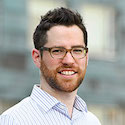“The Polarizers”: Colloquium with Colgate Prof. Sam Rosenfeld
01/01/1970
First, a definition. In recent times, ‘polarized’ has become ubiquitous in political discourse, and it has taken on multiple points of reference as its “star” has risen: a movement to extremes, for example, or a decline in civility. While these versions of the term certainly—too often, detrimentally—exist, Colgate University Professor Sam Rosenfeld’s October 12 talk at the Kinder Institute used a more historical lens, defining polarization as a deliberately choreographed sorting of parties by ideology that took place in the post-WW II era.
Though not an official origin point, he traced this phenomenon of polarization-as-“orchestrated gambit” back to the lead up to the 1944 presidential election, when FDR and Republican hopeful Wendell Willkie mutually lamented that both parties had become hybrids and conspired to re-organize them more firmly along liberal and conservative lines. In spite of their efforts, the era of consensus lingered until the 1970s, when the nation saw a runaway increase in polarization. Still, Prof. Rosenfeld explained, while polarization may not have fully taken hold until the 70s, the need for greater party discipline remained a “live question” in the decades prior, with proponents of a more distinct liberal-conservative divide claiming that bipartisan cooperation thwarted policy goals, blurred lines of political accountability, and muddied voter choice.
As a case study, he then traced these claims into the work of the liberal, amateur activists who made headway in transforming the Democratic party in the post-New Deal era (roughly 1945-1960). For one, he noted how they drew much of their vocabulary from the arguments of mid-century political scientists, like E.E. Schattschneider, who deemed the local- and regionalized aggregation of party power to be an arcane practice that hamstrung the federal government on issues like civil rights and who, in turn, promoted programmatic, disciplined parties with mutually distinct agendas and coherent plans of action. On the ground, the theories of figures like Schattschneider translated into activists’ efforts to disempower Southern Democrats by gaining control of the party in states where it had become weakened and, in states where that wasn’t possible, by establishing reform beachheads that lobbied to bring issues of national prominence more to the forefront of party rhetoric.
It was out of these coordinated efforts that larger scale innovations emerged. During his time as DNC Chairman, for example, Paul Butler introduced changes to steer the party toward greater coherence—a national council, for example, that would promulgate Democratic policy positions in the four years between conventions; and he also pushed for new protocols in Congress aimed at undermining the pragmatic, consensus-building norms that he found overly timid: the development of an organized whip system, and the elimination of both the filibuster and committees structured around seniority. The Democratic party, Butler hoped, would no long be seen as one of accommodation, compromise, and attainability, but rather as one of steadfast liberal principles that were clearly distinguishable from their conservative counter-positions.
So why did all of this go off the rails? How did we get from parties of principle to the bitter divisiveness that we see today? As Prof. Rosenfeld discussed at the end of his talk, the problem can be construed as both an institutional failure on the part of the reformers and as an individual failure on the part of voters and elected officials. Institutionally, those who aspired to create a more polarized D.C. falsely assumed that unified party control of the executive and legislative branches would persist. At the individual level, reformers simply underestimated the idiosyncratic lows of political psychology, specifically how severe issue- and party-identification would become and how destructive this would be to preserving any form of civil, deliberative capacity.
 Sam Rosenfeld received his B.A. in History from Columbia University, and his M.A. and Ph.D. in History from Harvard University. He currently teaches in the Political Science Department at Colgate University, after stops at Wesleyan University and Hamilton College. His first book, The Polarizers: Postwar Architects of Our Partisan Era, was published in 2018 by University of Chicago Press, and his articles and book reviews have appeared in Journal of Policy History, Democracy: A Journal of Ideas, and The American Prospect, among other places.
Sam Rosenfeld received his B.A. in History from Columbia University, and his M.A. and Ph.D. in History from Harvard University. He currently teaches in the Political Science Department at Colgate University, after stops at Wesleyan University and Hamilton College. His first book, The Polarizers: Postwar Architects of Our Partisan Era, was published in 2018 by University of Chicago Press, and his articles and book reviews have appeared in Journal of Policy History, Democracy: A Journal of Ideas, and The American Prospect, among other places.
FEATURED EVENTS
10/14/2025
09/21/2025
09/26/2025
07/22/2025
